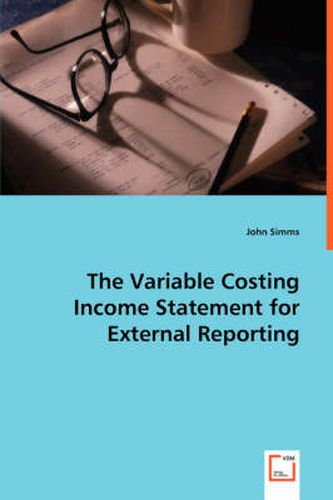Readings Newsletter
Become a Readings Member to make your shopping experience even easier.
Sign in or sign up for free!
You’re not far away from qualifying for FREE standard shipping within Australia
You’ve qualified for FREE standard shipping within Australia
The cart is loading…






This title is printed to order. This book may have been self-published. If so, we cannot guarantee the quality of the content. In the main most books will have gone through the editing process however some may not. We therefore suggest that you be aware of this before ordering this book. If in doubt check either the author or publisher’s details as we are unable to accept any returns unless they are faulty. Please contact us if you have any questions.
Beginning in 1936, a conversation among academics, practitioners, and regulators took place as to whether absorption (full) costing or variable (direct) costing was the appropriate method of presenting the financial statements. Proponents of each method were adamant and the theoretical debate raged intermittently until the early 1970s, when absorption costing won out as part of U.S. Generally Accepted Accounting Principles. The question was divided into two non-exclusive possibilities: differences in utility of the information must arise from either the format or the content of the statements. This study shows that the format alone has no effect on the estimate of future firm performance. Therefore, if there is any difference in the information content between statements based on a variable costing methodology and those using an absorption costing methodology, it must reside solely in the content of the statements. This provides the basis for much of the subsequent literature concerning the effect of operating leverage on estimates of future firm performance.
$9.00 standard shipping within Australia
FREE standard shipping within Australia for orders over $100.00
Express & International shipping calculated at checkout
This title is printed to order. This book may have been self-published. If so, we cannot guarantee the quality of the content. In the main most books will have gone through the editing process however some may not. We therefore suggest that you be aware of this before ordering this book. If in doubt check either the author or publisher’s details as we are unable to accept any returns unless they are faulty. Please contact us if you have any questions.
Beginning in 1936, a conversation among academics, practitioners, and regulators took place as to whether absorption (full) costing or variable (direct) costing was the appropriate method of presenting the financial statements. Proponents of each method were adamant and the theoretical debate raged intermittently until the early 1970s, when absorption costing won out as part of U.S. Generally Accepted Accounting Principles. The question was divided into two non-exclusive possibilities: differences in utility of the information must arise from either the format or the content of the statements. This study shows that the format alone has no effect on the estimate of future firm performance. Therefore, if there is any difference in the information content between statements based on a variable costing methodology and those using an absorption costing methodology, it must reside solely in the content of the statements. This provides the basis for much of the subsequent literature concerning the effect of operating leverage on estimates of future firm performance.